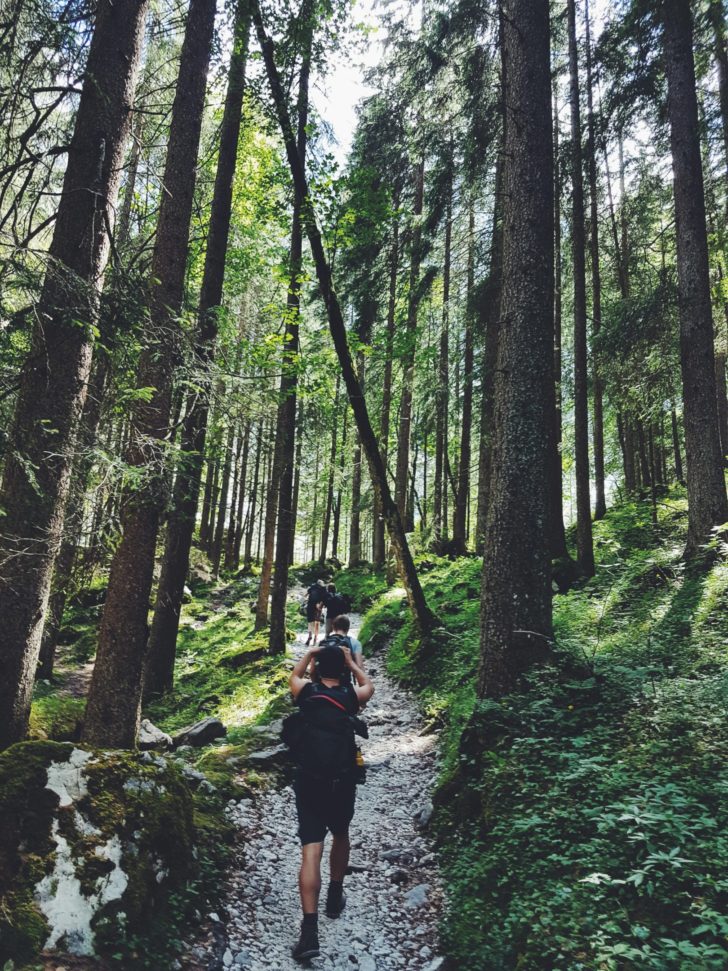Trail running: a thrilling adventure that takes you off the beaten path and into the heart of nature. Whether you’re a seasoned runner seeking a new challenge or a beginner looking to explore the great outdoors, trail running offers a unique and enjoyable way to exercise while soaking in the beauty of your surroundings. In this comprehensive guide, we’ll cover everything you need to know to embark on your trail running journey, from getting started and choosing the right gear to honing your technique and finding the perfect race. So lace up those trail shoes and let’s hit the trails!
Table of Contents
Key Takeaways
Explore the joys of trail running by discovering local trails and investing in quality shoes!
Enjoy physical & mental benefits with specialized techniques, equipment, and safety gear.
Practice trail etiquette to create a positive experience for all & preserve the environment!
Getting Started with Trail Running

Embarking on your trail running adventure is easier than you might think. Simply start by exploring familiar local trails, such as your neighborhood hiking path or dog-walking route, for a casual trail run. As a novice, you should consider investing in a quality pair of trail running shoes that deliver the requisite traction, support, and protection for tackling uneven surfaces. Remember to take it easy at first, gradually building your confidence and skills on shorter distances and smoother trails before tackling more challenging terrain.
Trail running offers numerous benefits, including improved mental health, increased agility, and a full-body workout. In fact, trail running can lead to a more varied and stimulating workout compared to road running, engaging different muscle groups and helping to improve balance and coordination.
Why hesitate? Embrace the trails and uncover the thrilling realm of trail running!
Benefits of Trail Running
Trail running provides a fantastic workout that engages your entire body, from your core to your legs. The benefits of trail running include:
Improved balance and coordination due to the varied terrain and natural obstacles
Increased agility and resilience as you navigate the trails
Reduced risk of overuse injuries due to the softer surface compared to roads
Increased calorie burn compared to running on flat surfaces
But it’s not just the physical benefits that make trail running so appealing. Connecting with nature and escaping the hustle and bustle of everyday life can do wonders for your mental wellbeing. Trail running allows you to practice mindfulness, boost your emotional resilience, and experience a sense of accomplishment as you conquer new challenges.
Don’t wait, tighten those laces and experience the remarkable advantages of trail running firsthand!
Learn more, visit 10 Benefits Of Trail Running.
Differences Between Trail and Road Running
While trail running shares some similarities with road running, there are key differences that make it a unique and exciting experience. Trail running takes place on uneven and varied terrain, such as dirt paths, rocky trails, and steep inclines, whereas road running provides a smooth, paved surface. This rugged terrain requires a different approach to foot placement, stride, and body positioning, as well as specialized trail running shoes with added traction and support.
Additionally, trail running often involves a slower pace due to the challenging terrain, emphasizing the enjoyment of the natural environment rather than achieving specific times or distances. So, if you’re ready to swap the pavement for the great outdoors, trail running might just be the adventure you’re looking for.
Choosing the Right Trail Running Shoes

Choosing suitable trail running shoes is vital for ensuring comfort, safety, and performance during your trail runs. Trail-specific shoes offer better traction, foot protection, and support than regular running shoes, enabling you to navigate various trail surfaces with confidence. When choosing your perfect pair, consider factors such as the environment in which you’ll be running, as well as your individual preferences and needs.
In subsequent sections, we’ll discuss vital features of trail running shoes, such as traction and foot protection, supporting you in making a knowledgeable choice.
Shoe Traction
Navigating the diverse terrain of trail running requires shoes with excellent traction. Shoe traction provides a secure grip on different surfaces, helping you stay in control and build confidence while navigating through various trail conditions. Materials such as rubber, specifically those with lugged soles and sticky rubber compounds like Vibram Megagrip, provide unbeatable grip on:
dirt
mud
gravel
roots
rock slabs
The design of the tread pattern affects the real contact area between the shoe and the surface, which ultimately determines the level of traction. So, when selecting your trail running shoes, be sure to prioritize traction and grip to ensure a safe and enjoyable running experience.
Foot Protection and Support
In addition to traction, foot protection and support are essential features of trail running shoes. Options range from minimalist designs with minimal cushioning for a lighter feel to maximalist shoes that prioritize comfort and provide unparalleled cushioning for an incredibly smooth and comfortable trail running experience with trail shoes.
Materials such as:
Polyurethane foam midsoles
Rubber outsoles
Synthetic overlays
Vibram Megagrip
offer maximum foot protection and stability on rugged trails. So, whether you prefer a minimalist or maximalist approach, make sure to choose shoes that provide the necessary protection and support for your trail running adventures.
Essential Trail Running Gear
With the right shoes in place, you’re ready to equip yourself for your trail running expedition. Essential equipment includes appropriate clothing, hydration solutions, and safety equipment to ensure a comfortable and enjoyable experience.
The upcoming sections will delve into these essentials, equipping you with the necessary knowledge and confidence to venture onto the trails fully prepared and poised for an adventure.
Clothing for Trail Running
When it comes to clothing for trail running, opt for moisture-wicking, breathable materials such as synthetic fabrics or merino wool, and avoid cotton. Dressing in layers is a great way to ensure comfort throughout your run, allowing you to easily adjust your outfit as your body temperature fluctuates.
Don’t forget to wear sun protection, including a hat and sunglasses, to shield yourself from harmful UV rays. By choosing the right clothing, you’ll stay comfortable and focused on your trail running goals.
Hydration Solutions
Staying hydrated is crucial during trail running, and there are plenty of options to ensure you have easy access to water throughout your run. Handheld water bottles, waistpacks with water bottles, and hydration vests or packs all offer various ways to carry water on the trail. Each option has its advantages and disadvantages, so choose the one that best suits your personal preference and the duration of your run.
Remember, staying hydrated is key to maintaining peak performance and enjoying your trail running experience.
Safety Equipment
Safety is paramount when hitting the trails, so be prepared with essential safety equipment. Here are some items to consider:
Navigation tools, such as a physical map or GPS unit, can help you stay on track and prevent getting lost.
A headlamp is necessary for nighttime or low-light conditions, providing visibility and ensuring your safety on the trail.
Sun protection, including sunscreen, lip balm, and sun-protective clothing, will shield you from harmful UV rays.
And lastly, a first-aid kit is a must-have for treating minor injuries and emergencies. Equipped with the right safety gear, you’ll be ready to tackle any trail with confidence.
Developing Trail Running Technique

As you embark on your trail running journey, mastering the appropriate technique to efficiently and safely maneuver uneven terrain is key. This involves focusing on foot placement, stride, and body positioning.
Subsequent sections will detail these components of trail running technique, arming you with the requisite know-how and skills to master any trail.
Foot Placement and Stride
In trail running, foot placement and stride play a crucial role in maintaining balance and minimizing impact. Quick, light steps and adaptability to changing surfaces are key for efficient and safe movement on the trails. When navigating uneven terrain, it’s important to stay upright and position your body over your toes for better balance and stability.
By focusing on proper foot placement and stride, you’ll be well on your way to mastering the art of trail running.
Body Positioning
Body positioning in trail running involves a slightly forward lean, engaging the core, and using arms for balance and momentum. This posture helps you maintain control, especially on uphill and downhill sections. As you ascend, take shorter strides and keep your posture upright, with your head level and arms held close to your body.
When descending, stay balanced and focus on your foot placement, slightly leaning forward and positioning your body over your toes. By mastering these body positioning techniques, you’ll be well-equipped to tackle even the most challenging trails with ease and confidence.
Finding Local Trails and Running Clubs
At the onset of your trail running journey, discovering local trails and becoming part of running clubs can offer priceless support and inspiration. These resources offer opportunities for:
Group runs
Advice from experienced trail runners
Exploring new trails
Participating in organized events
Upcoming sections will guide you on how to uncover local trails and engage with running clubs, enriching your trail running journey.
Discovering Local Trails
To find local trails suitable for trail running, you can:
Explore online resources such as AllTrails, Hiking Project, Garmin Connect, Strava, and TrailLink
Check out guidebooks and recommendations from fellow runners
Start with easier routes and gradually progress to more challenging terrain as your skills and confidence grow.
With a wealth of resources at your fingertips, you’ll quickly discover a variety of exciting trails to explore.
Joining Running Clubs
Joining a running club or group can provide camaraderie, motivation, and guidance for new trail runners. Websites such as Trail Sisters, Trail Runner’s Club, and Meetup offer a great starting point for finding running clubs in your area. As a member, you’ll have the opportunity to explore new trails, participate in organized events, and connect with like-minded individuals who share your passion for trail running.
So, don’t hesitate to join a running club and enhance your trail running experience with the support and encouragement of fellow runners, like those in the American Trail Running Association.
Preparing for Trail Running Races
After enhancing your trail running skills and boosting your confidence, you might be excited to put these abilities to the test in a trail running race. Preparing for a race involves researching popular events, developing a training plan, and gradually increasing distance and difficulty to build endurance and skill.
The sections ahead will explore popular trail running races and offer training tips, preparing you to take on any race.
Popular Trail Running Races
Trail running races offer an exhilarating challenge for runners of all skill levels, with events ranging from local 5Ks to international ultramarathons. Popular races, such as TransJeju by UTMB in South Korea, Útilív Adventure Festival in the Faroe Islands, and Tarawera Ultra Marathon in New Zealand, showcase stunning routes and diverse terrains that cater to a variety of preferences. In addition, the International Trail Running Association plays a significant role in promoting and organizing these events worldwide.
With countless races to choose from, you’re sure to find an event that matches your skill level and goals.
Training for Trail Running Races
To prepare for a trail running race, it’s essential to develop a well-rounded training plan that includes a mix of distance runs, hill workouts, and cross-training exercises to build strength, endurance, and agility specific to trail running. Resources such as Trail Running Movement, Trail Runner Magazine, and REI offer training plans tailored to your fitness level, race distance, and objectives.
By following a structured plan and gradually increasing the intensity of your workouts, you’ll be well-prepared to tackle any trail running race with confidence and determination.
Mountain Running: A Specialized Form of Trail Running
For those seeking an even greater challenge, mountain running offers a specialized form of trail running that involves navigating steep, high-altitude terrain. This demanding sport requires additional equipment and techniques to conquer the rugged trails and breathtaking elevation gains found in mountain running.
The upcoming sections will delve into the specialized equipment and techniques necessary for excelling in this thrilling sport.
Equipment for Mountain Running
Mountain running demands specialized gear to ensure optimal performance and safety on steep, rugged trails. Key equipment includes:
Trekking poles for added stability and propulsion
Gaiters to protect your legs from debris
Footwear designed for increased traction and support on uneven surfaces
Mountaineering gear such as boots, crampons, a climbing helmet, and an ice axe may be necessary for more technical mountain runs.
With the right equipment, such as a mountain bike, you’ll be well-equipped to tackle the thrilling challenge of mountain running.
Techniques for Mountain Running
Mountain running requires specific techniques to efficiently and safely navigate steep, technical terrain. Power hiking on steep inclines can help conserve energy while maintaining progress. Maintaining a steady pace and adapting your stride and body positioning for uphill and downhill movement is crucial for success in mountain running.
By mastering these techniques, you’ll be well-prepared to conquer the exhilarating challenge of mountain running, with its significant elevation gain, and reach new heights in your trail running journey.
Practicing Trail Etiquette
As you set out on the trails, adhering to proper trail etiquette is key to fostering a positive experience for all and preserving the natural environment for future generations.
Subsequent sections will detail essential elements of trail etiquette, encompassing Leave No Trace principles and respect for other trail users.
Leave No Trace Principles
Adhering to Leave No Trace principles is vital for minimizing your impact on the environment while trail running. These principles include:
Planning ahead and preparing
Staying on designated trails
Packing out all trash
Respecting wildlife and plant life
By following these guidelines, you’ll help preserve the trails and natural habitats for future generations, while also fostering a sense of community and environmental stewardship among trail runners.
Sharing the Trail with Other Users
Sharing the trail with other users, such as hikers, cyclists, and equestrians, involves being aware of your surroundings, yielding to others when appropriate, and practicing courteous behavior. By being considerate and respectful of other trail users, you’ll contribute to a positive atmosphere on the trails and ensure an enjoyable experience for all.
So, as you venture out on your trail running adventures, remember to be mindful of your fellow trail users and practice good trail etiquette.
Summary
In conclusion, trail running offers an exciting and rewarding way to explore the great outdoors while reaping numerous physical and mental benefits. By getting started on local trails, choosing the right gear, developing proper technique, and participating in races and clubs, you’ll be well on your way to becoming an accomplished trail runner. And by practicing trail etiquette and Leave No Trace principles, you’ll help preserve the beauty of nature for future generations to enjoy. So, lace up those trail shoes and embark on your trail running adventure – the trails await!
Frequently Asked Questions
Is trail running harder than running?
Trail running is undeniably harder than road running, as the uneven and unpredictable terrain requires extra effort and care to navigate. However, it can be an incredibly rewarding experience that many runners enjoy.
What trail running means?
Trail running is an all-round non-stadia sport of running in nature that works the legs, upper body, and requires concentration and attention.
What type of shoes should I wear for trail running?
For the best trail running experience, look for a pair of shoes designed specifically for off-road terrain – they’ll provide you with superior traction, foot protection, and support. Find shoes that suit your individual preferences and the environment in which you’ll be running for a safe and enjoyable adventure!
How can I find local trails suitable for trail running?
Unlock the best trails for your running adventures with the help of online resources such as AllTrails, Hiking Project, Garmin Connect, Strava, and TrailLink, plus guidebooks and advice from fellow runners.
What training exercises can help me improve my trail running performance?
Improve your trail running performance with a combination of distance runs, hill workouts, and cross-training exercises like cycling, swimming, hiking, strength training, and plyometrics for increased strength, endurance, and agility.









